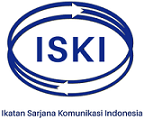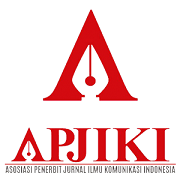Vaksinasi Covid-19 di Media Sosial Twitter; Tinjauan Content dan Social Network Analysis
Abstract
Abstrak
Tujuan dari penelitian ini diantaranya untuk mengetahui narasi yang dibangun dalam percakapan di media sosial; mengetahui efektivitas penyebaran informasi yang dilakukan berdasarkan tagar yang #vaksin; dan memetakan polarisasi sikap masyarakat terhadap vaksin COVID-19. Metode yang digunakan adalah content analysis dan juga social network analysis dari data percakapan di media sosial Twitter dari tanggal 12 Januari 2021 sampai dengan 3 Februari 2021. Narasi yang dibangun dalam percakapan di media sosial Twitter terkait dengan tagar #vaksin adalah 1) Penggunaan tokoh sebagai role model perilaku untuk mengikuti program vaksin; 2) Tata cara pendaftaran vaksin; 3) Urgensi vaksinasi di tengah pandemi oleh tokoh agama; 4) Narasi vaksin berbayar. Efektivitas pesan yang disampaikan dalam percakapan di media sosial berdasarkan analisis jaringan menunjukkan bahwa penyebaran pesan tidak terlalu luas. Gencarnya kampanye vaksin menunjukkan perubahan sikap yang lebih positif terhadap vaksin itu sendiri.
Abstract
The aims of this research are to find out the narrative that is built in conversations on social media; find out the effectiveness of information dissemination based on the #vaccine hashtag; and polarization of public attitudes towards the COVID-19 vaccine. The method used is content analysis and also social network analysis from conversation data on Twitter from January 12,to February 3, 2021. The narrative related to the hashtag #vaccin is 1) The use of characters as roles behavioral models for following a vaccine program; 2) Vaccine registration procedures; 3) The urgency of vaccination in the midst of a pandemic by religious leaders; 4) Paid vaccine narrative. The effectiveness of messages conveyed in conversations on social media based on network analysis shows that the spread of messages is not too wide. The incessant vaccine campaign shows a more positive attitude towards the vaccine itself.
Abstrak
Tujuan dari penelitian ini diantaranya untuk mengetahui narasi yang dibangun dalam percakapan di media sosial; mengetahui efektivitas penyebaran informasi yang dilakukan berdasarkan tagar yang #vaksin; dan memetakan polarisasi sikap masyarakat terhadap vaksin COVID-19. Metode yang digunakan adalah content analysis dan juga social network analysis dari data percakapan di media sosial Twitter dari tanggal 12 Januari 2021 sampai dengan 3 Februari 2021. Narasi yang dibangun dalam percakapan di media sosial Twitter terkait dengan tagar #vaksin adalah 1) Penggunaan tokoh sebagai role model perilaku untuk mengikuti program vaksin; 2) Tata cara pendaftaran vaksin; 3) Urgensi vaksinasi di tengah pandemi oleh tokoh agama; 4) Narasi vaksin berbayar. Efektivitas pesan yang disampaikan dalam percakapan di media sosial berdasarkan analisis jaringan menunjukkan bahwa penyebaran pesan tidak terlalu luas. Gencarnya kampanye vaksin menunjukkan perubahan sikap yang lebih positif terhadap vaksin itu sendiri.
Keywords
Full Text:
PDFReferences
(KKRI), K. K. (2020). LINDUNGI VAKSINASI COVID-19. Retrieved from https://promkes.kemkes.go.id/pub/files/files70010flyer%20vaksin%20c19%20(rev%203).pdf
Castillo, C., Mendoza, M., & Poblete, B. (2011). Information credibility on twitter. the 20th international conference on World wide web, (pp. 675–684).
Davis, G. F., & Greve, H. R. (1997). Corporate Elite Networks and Governance Changes in the 1980s. American Journal of Sociology, 1-37.
Davis, G. F., Yoo, M., & Baker, W. E. (2003). The Small World of the American Corporate Elite, 1982-2001. Strategic Organization.
Eriyanto. (2014). Analisis jaringan komunikasi : strategi baru dalam penelitian ilmu komunikasi dan ilmu sosial lainnya . Jakarta: Prenadamedia Group.
Garton, L., Haythornthwaite, C., & Wellman, B. (1997). Studying Online Social Networks. Journal of Computer-Mediated Communication.
Hakim, R. N. (2021, Januari 20). Hoaks yang Beredar di Tengah Program Vaksinasi Covid-19 Tahap Pertama. Retrieved from Kompas.com: https://nasional.kompas.com/read/2021/01/20/18445061/hoaks-yang-beredar-di-tengah-program-vaksinasi-covid-19-tahap-pertama?page=all#page1
Hung, M., Lauren, E., Hon, E. S., Birmingham, W. C., Xu, J., Su, S., . . . Lipsky, M. S. (2020). Social Network Analysis of COVID-19 Sentiments: Application of Artificial Intelligence. Journal of Medical Internet Reseach.
Newman, M. E. (2004). Coauthorship networks and patterns of scientific collaboration. Proceedings of the National Academy of Sciences.
Nuraini, T. N. (2021, January 14). Ramai Disorot Tangan Gemetar Saat Suntik Jokowi, Begini Kata Dokter Abdul Mutalib. Retrieved from Merdeka.com: https://www.merdeka.com/trending/ramai-disorot-tangan-gemetar-saat-suntik-jokowi-begini-kata-dokter-abdul-mutalib.html
P.Borgatti, S., & C.Foster, P. (2003). The Network Paradigm in Organizational Research: A Review and Typology. Journal of Management, 991-1013.
Palen, L., & Vieweg, S. (2008). The emergence of online widescale interaction in unexpected events: assistance, alliance & retreat. ACM conference on Computer supported cooperative work, (pp. 117–126).
Pamekar, G. G. (2010). Efektivitas Metode Role Playing dan Role Model dalam Program Kampanye Sosial. Jurnal: ILMU KOMUNIKASI.
Pryke, S. D. (2004). Analysing construction project coalitions: exploring the application of social network analysis. Construction Management and Economics, 787-797.
Serrat, O. (2009). Social Network Analysis. Knowledge Solutions.
Shalihah, N. F. (2021, January 6). Vaksinasi Covid-19 Dimulai 13 Januari, Waspada 5 Hoaks Soal Vaksin Ini. Retrieved from Kompas.com: https://www.kompas.com/tren/read/2021/01/06/140000165/vaksinasi-covid-19-dimulai-13-januari-waspada-5-hoaks-soal-vaksin-ini?page=all#page1
Starbird, K., Palen, L., Hughes, A. L., & Vieweg, S. (2010). Chatter on the red: what hazards threat reveals about the social life of microblogged information. CSCW '10: Proceedings of the 2010 ACM conference on Computer supported cooperative work, (pp. 241–250).
Stuart, T. E. (1998). Network Positions and Propensities to Collaborate: An Investigation of Strategic Alliance Formation in a High-Technology Industry. Administrative Science Quarterly, 668-698.
Tsai, M. H., & Wang, Y. (2020). Analyzing Twitter Data to Evaluate People’s Attitudes towards Public Health Policies and Events in the Era of COVID-19. International Journal of Environmental Research and Public Health.
Vieweg, S. (2010). Microblogged contributions to the emergency arena: Discovery, interpretation and implications. Computer Supported Collaborative Work.
Wasserman, S., & Faust, K. (1994). Social Network Analysis: Methods and Applications. Cambridge University Press.
Yates, D., & Paquette, S. (2011). Emergency knowledge management and social media technologies: A case study of the 2010 Haitian earthquake. International Journal of Information Management, 6-13.
DOI: http://dx.doi.org/10.30829/komunikologi.v5i2.9771
Refbacks
- There are currently no refbacks.
Copyright (c) 2021 Vici Sofianna Putera, Dwi Agustin Nuriani Sirodj, Rizka Hadian Permana

This work is licensed under a Creative Commons Attribution-ShareAlike 4.0 International License.
INDEXING BY :
======================================
Published by :
Fakultas Ilmu Sosial UIN Sumatera Utara
Medan, Indonesia
Editorial Office :
Jl. Lap. Golf No.120, Kp. Tengah, Kec. Pancur Batu, Kabupaten Deli Serdang, Sumatera Utara 20353

Komunikologi: Jurnal Pengembangan Ilmu Komunikasi dan Sosial by Program Studi Ilmu Komunikasi UIN Sumatera Utara Medan is licensed under a Creative Commons Attribution-ShareAlike 4.0 International License
Based on a work at http://jurnal.uinsu.ac.id/index.php/KOMUNIKOLOGI/index





























